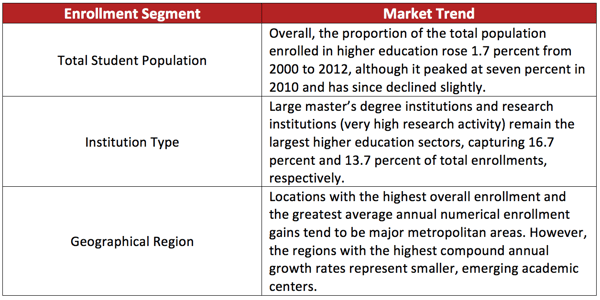Published on
Higher Education’s Enrollment Bubble: A Trends Analysis

If higher education is a bubble, when will it burst?
The sudden decline in overall student enrollment in 2012 posed serious problems for certain institutions with regard to short‐term revenues and long‐term viability. Some missed enrollment targets by huge margins, creating panicked efforts for last‐minute summer enrollments as a means of sustaining operating budgets.[1] A recent U.S. Census Bureau report confirmed the continuation of this decline into 2013, as college enrollment decreased for the second straight year with a drop of 2.3 percent to 19.5 million students enrolled. The cumulative two-year decline of 930,000 students was larger than any college enrollment decrease before the recent recession.[2]
Observers attribute this negative trend to a decrease in the number of 18‐year-olds in the overall population, the rising cost of tuition standing as a barrier to college entry, economic recovery allowing more to choose employment over continued education, and the leveling off of high school graduation rates.[3] As Inside Higher Ed further noted:
College enrollments typically fall or flatten when the economy improves, so the [National Student] Clearinghouse’s report of declines isn’t terribly surprising (despite the relatively slow improvement in the job market, as defined by unemployment figures). But the size of the decrease is likely to be of concern to college officials trying to fill their classes to deal with increased costs or flattening state support.[4]
The nation’s downward enrollment trend poses a number of challenges for institutions working to maximize an already finite resource pool. In its September 2014 Higher Education Outlook Survey, KPMG reported that 85 percent of higher education leaders are either “very” or “somewhat” concerned about maintaining current enrollment levels—a 14-percent increase from the 2013 report. Further, competition for students amongst peer institutions compels colleges to maintain spending on academic programs and amenities—which is often counterproductive in combatting the rising price of tuition and expanding educational access for low-income students.[5]
Is Higher Education One Large Bubble?
American economist Richard Vedder and the Center for College Affordability and Productivity’s Christopher Denhart have argued since 2010 that higher education produces too many graduates. Citing data on the under‐employment of college graduates – for example, 15 percent of taxi drivers now hold a bachelor’s degree compared to just one percent in 1970—they believe the government needs to rethink education policies that blindly and solely subsidize bachelor of arts programs.[6] In a 2014 reprise on this theme, they cited additional data on the declining dollar value of a degree in terms of median earnings, and a particularly strong decline of female enrollments in comparison to male enrollments.[7] Education policy expert George Leef and others have echoed these sentiments, warning that a college degree does have some value to some people, but should not be considered “a panacea for all personal and social problems.”[8]
Critics point out that arguments like Vedder and Denhart’s are based more on philosophy than statistics, in spite of constant reference to student loan data. Journalist Daniel Luzer points out that students at for-profit institutions struggle the most with default, risky loan terms, and program non-completion, so declining enrollment at these for-profit entities might mean that “hazardous student loans are […] actually shrinking.”[9] Furthermore, in spite of the very personal impact they have on individuals, student loans are a small and safe (or rather, an irrational yet inescapable) investment market relative to the housing market to which we try to equate them.[10, 11]
Or, Are Smaller Bubbles Causing Enrollment Decline?
The Atlantic’s Jordan Weissmann sees things a bit differently, however. Instead of an overall bubble, he suggests a more nuanced examination in which we recognize that for‐profit and two‐year institutions have been disproportionately affected, while public and four‐year institutions have seen enrollment growth. “All of the declines happened in the troubled for‐profit sector,” he wrote, “which has cut back somewhat on enrolling clearly under‐qualified students in an effort to clean up its image, and community colleges, which have been grappling with overcrowding in recent years.”[12]
Others wonder about the student perspective and the efforts of institutions to appeal to new or changing markets, especially two-year transfer and foreign students.[13] Students are becoming more critical of certain higher degrees in law and business, for example, and are no longer settling for middle-of-the-pack options. With the value of these degrees under scrutiny, many students find that enrolling in the programs doesn’t make sense, and some institutions may see declines in their incoming cohorts as a result.[14]
Alternatively, institutions themselves might benefit from restricting enrollment. Saint Michael’s College in Vermont, for example, saw a decline in the number of enrollments in its area’s high schools. The institution noted its pricing model may be unsuitable for this change in demand, and thus responded by decreasing enrollment by 10 to 15 percent across a four-year period. In the case of Saint Michael’s College, shrinking is seen as strategy, and administrators noted that the college’s sustainability will increase as its size decreases.[15]
What Do These Enrollment Trends Mean for the Higher Education Market?
Regardless of why the bubble may burst or even what it looks like, a decrease in enrollment translates to a decrease in tuition revenue and, for many institutions, results in an unexpected resource deficiency. To address the implications of overall student enrollment on higher education market, we uncovered the following key trends.

In the coming weeks, institutions will continue to report their successes and shortfalls for the 2014-15 academic year. The Chronicle of Higher Education estimates that 38 percent of small private colleges and midsize state institutions failed to meet their 2014 goals for both freshman enrollment and net tuition revenue. Whether these experiences amount to a higher education crisis remains unclear.[16]
If higher education is one big bubble, it has a lot to do with student loans and students’ ability to afford degrees. If it is not one big bubble, what we see in the market is a reflection of the honing of individual choices by both students and institutions―students running from risky for-profits or middle-grade professional programs, and colleges and universities acknowledging that growth is not a constant or perfect metric of success and ability.
– – – –
References
[1] Cameron McWhirter and Douglas Belkin, “Student Drought Hits Smaller Universities,” The Wall Street Journal, July 25, 2013. Accessed at http://online.wsj.com/news/articles/SB10001424127887323971204578628230654653180
[2] “College Enrollment Declines for Second Year in a Row, Census Bureau Reports,” United States Census Bureau Press Release, September 24, 2014. Accessed at http://www.census.gov/newsroom/press-releases/2014/cb14-177.html#
[3] Richard Perez-Pena, “College Enrollment Falls as Economy Recovers,” The New York Times, July 25, 2013. Accessed at http://www.nytimes.com/2013/07/26/education/in-a-recovering-economy-a-decline-in-college-enrollment.html?pagewanted=all&_r=1&
[4] Doug Lederman, “Enrollment Decline Picks Up Speed,” Inside Higher Ed, May 17, 2013. Accessed at https://www.insidehighered.com/news/2013/05/17/data-show-increasing-pace-college-enrollment-declines
[5] “Increasing Number of College and University Leaders Concerned About Maintaining Student Enrollment, Says KPMG Survey,” KPMG Press Release, September 17, 2014. Accessed at http://www.kpmg.com/US/en/IssuesAndInsights/ArticlesPublications/Press-Releases/Pages/Increasing-Number-Of-College-And-University-Leaders-Concerned-About-Maintaining-Student-Enrollment-Says-KPMG-Survey.aspx
[6] Matthew Denhart, “From Wall Street to Wal-Mart: Why College Graduates are not Getting Good Jobs,” Center for College Affordability and Productivity Press Release. Accessed at http://www.centerforcollegeaffordability.org/uploads/From_Wall_Street_to_Wal-Mart_PR.pdf
[7] Richard Vedder and Christopher Denhart, “How The College Bubble Will Pop,” The Wall Street Journal, January 8, 2014. Accessed at http://online.wsj.com/news/articles/SB10001424052702303933104579302951214561682?mod=hp_opinion
[8] George Leef, “The College Bubble Is Popping, So Shameless Sales Pitches Pick Up,” Forbes Magazine, November 26, 2013. Accessed at http://www.forbes.com/sites/georgeleef/2013/11/26/the-college-bubble-is-popping-so-shameless-sales-pitches-pick-up/
[9] Daniel Luzer, “Higher Education Is Not a Bubble,” Washington Monthly, March 5, 2013. Accessed at http://www.washingtonmonthly.com/college_guide/blog/higher_education_is_not_a_bubb.php
[10] Jordan Weissmann, “Don’t Panic: Wall St.’s Going Crazy for Student Loans, but This Is No Bubble,” The Atlantic, March 4, 2013. Accessed at http://www.theatlantic.com/business/archive/2013/03/dont-panic-wall-sts-going-crazy-for-student-loans-but-this-is-no-bubble/273682/
[11] Cliff Kuang, “Is U.S. Higher Education A Bubble Economy?” Fast Company, February 7, 2012. Accessed at http://www.fastcodesign.com/1668981/is-us-higher-education-a-bubble-economy-infographic-video
[12] Jordan Weissmann, “No, The ‘College Bubble’ Isn’t Popping,” The Atlantic, January 9, 2014. Accessed at http://www.theatlantic.com/business/archive/2014/01/no-the-college-bubble-isnt-popping/282958/
[13] Brian Mitchell, “Snap, Crackle and Pop: Thoughts on the College Enrollment Bubble,” The Huffington Post, January 14, 2014. Accessed at http://www.huffingtonpost.com/dr-brian-c-mitchell/snap-crackle-and-pop_b_4594225.html
[14] “The Latest Bubble?” The Economist, April 13, 2011. Accessed at http://www.economist.com/blogs/schumpeter/2011/04/higher_education
[15] Ry Rivard, “Shrinking as a Strategy,” Inside Higher Ed, April 9, 2014. Accessed at https://www.insidehighered.com/news/2014/04/09/vermont-liberal-arts-college-expecting-things-will-get-bad
[16] Scott Carlson, “Goals for Enrollment and Tuition Revenue Elude Many Colleges,” The Chronicle of Higher Education, October 13, 2014. Accessed at http://chronicle.com/article/Goals-for-Enrollment-and/149349/
Author Perspective: Association


